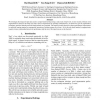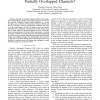26354 search results - page 7 / 5271 » How we refactor, and how we know it |
IJON
2007
13 years 7 months ago
2007
Despite a steady improvement of computational hardware, results of numerical simulation are still tightly bound to the simulation tool and strategy used, and may substantially var...
ISSAC
1999
Springer
13 years 12 months ago
1999
Springer
In this paper we consider the problem of fast computation of n-ary products, for large n, over arbitrary precision integer or rational number domains. The combination of loop unro...
LREC
2010
13 years 9 months ago
2010
We investigate the impact of input data scale in corpus-based learning using a study style of Zipf's law. In our research, Chinese word segmentation is chosen as the study ca...
WCNC
2008
IEEE
14 years 2 months ago
2008
IEEE
—Partially Overlapped Channel (POC) based design, has been identified recently as a promising technique to overcome the capacity bottleneck facing wireless engineers in various ...
CHI
2007
ACM
13 years 11 months ago
2007
ACM
A prototype of computing technology--as a means to evaluate and communicate a good idea--is often an essential step towards useful, shipping products and towards a deeper understa...



